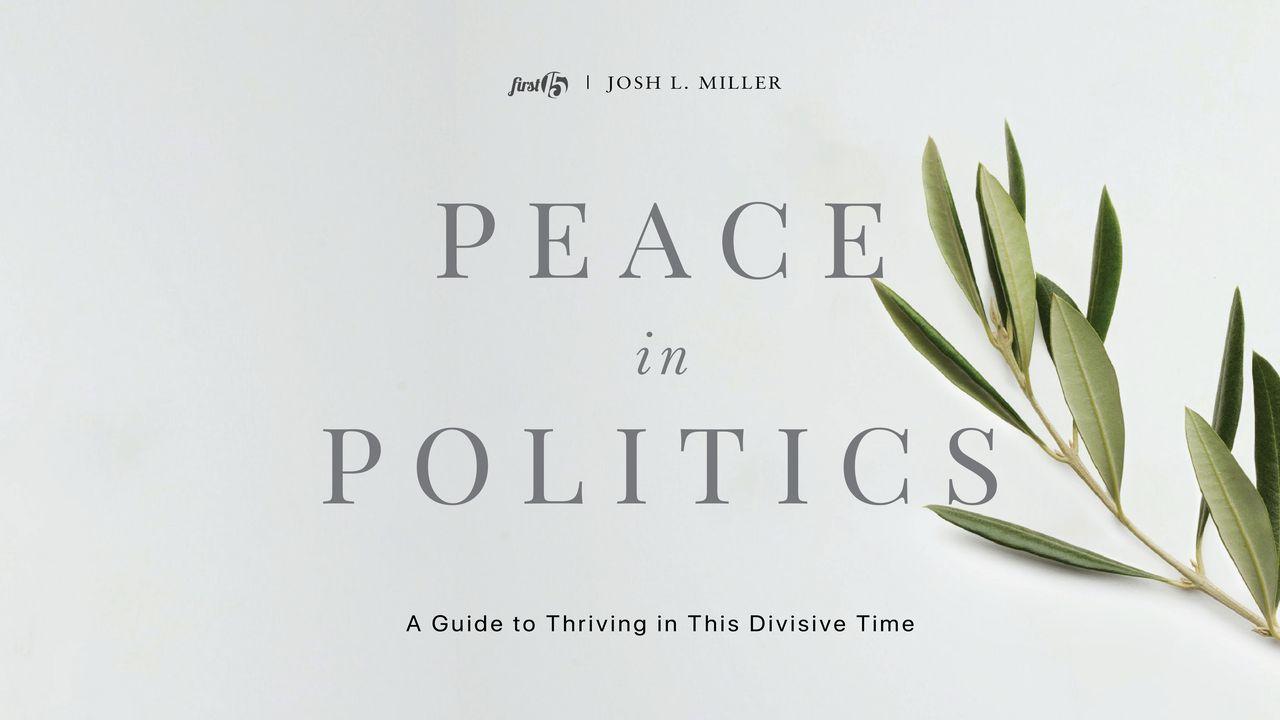Peace in Politics: A Guide to Thriving in This Divisive TimeSample

Day 6: Healthy Disagreement (Part 2)
As previously mentioned, there is no perfect person or party. Humility starts with full awareness of that truth. When we’re honest with others about where we fall short, we often earn their ear and their trust.
Another way we can learn to walk in humility is through serving others. Richard Foster writes, “More than any other single way the grace of humility is worked into our lives through the discipline of service . . . Nothing disciplines the inordinate desires of the flesh like service, and nothing transforms the desires of the flesh like serving in hiddenness. The flesh whines against service but screams against hidden service. It strains and pulls for honor and recognition.”
When we serve those around us, even those with whom we disagree, our ego and pride are transformed into love and compassion. A major indication of an unhealthy disagreement involves us elevating ourselves and our opinions. Serving pulls us back into a humble, loving, kingdom-minded perspective.
How can you love and serve the people with whom you disagree?
Even the thought of this question might sound painful, or irritating, which likely indicates how important this step really is.
Pseudo-peace
At this point you may be wondering how conflict, or serving those with whom we disagree, has anything to do with finding peace in this political season. Disagreement and conflict feel like the opposites of peace. They feel like something we should try to avoid. And while there is value in avoiding unnecessary conflict, healthy disagreements can function as a pathway toward true peace when we begin from a place of love and humility.
Have you ever been in a situation where the tension was so thick you could almost touch it? Or have you stood next to someone knowing that you needed to share what’s on your heart, even though it could lead to a fight? One option in these situations is to remain quiet, avoiding the conflict altogether in the name of peace. Yet, all you’re really left with is a pseudo-peace, an avoidance of the necessary confrontation. Artificial harmony is not peace. Avoidance of conflict is not love. It would be like leaving a splinter beneath the skin to avoid the pain of its removal. While it may delay some immediate discomfort, it ultimately leaves you with a lingering unease, anxiety, and a potential for greater issues.
True peace, at times, may only be found by humbly and lovingly stepping into the conflict with the purpose of seeking authentic harmony. This doesn’t require that everyone agree at the end of the disagreement. It does require that each person involved feels safe, heard, understood, and loved.
How to disagree
There are entire books dedicated to navigating conflict and disagreement, so it is impossible to fully cover the topic here. However, the practice section below includes several quick tips and resource links if you are looking for more guidance on the topic.
My hope today is to encourage you that conflict can be a positive thing when handled appropriately.
We have a lot in common
The last thing I’d like to mention is that it can be easy to focus on what divides us. Our differences tend to stand out and draw our attention since they push against our innate desire to be right. Yet people who think differently reveal that things aren’t always as simple as right or wrong.
The truth is that the things we have in common greatly outnumber the things that differ. John F. Kennedy said it best:
“What unites us is greater than what divides us”
Could it be that our pathway to peace involves remembering this truth, even in the midst of disagreement?
PRACTICE
- Reflect on any situations where you’re living in a pseudo-peace.
- Bring that situation before God and ask for him to show you his perspective. Ask how he would like you to work through it.
- Reflect on ways that you can serve someone you currently disagree with or are in conflict with. Take it a step further and serve them anonymously.
- Is there someone you need to seek peace with today? Do you need to ask for forgiveness for words that were spoken or harmful actions that were taken?
- Follow God’s direction in love and humility.
5 quick tips for having a difficult conversation:
- Examine your heart: Are you walking into the conversation with love and humility?
- Define your intentions: Are you trying to be right, or are you trying to better understand this person’s point of view?
- Ask good questions: Make it a goal to foster a conversation, not deliver a monologue.
- Can you help me understand your perspective on _______?
- I am hearing you say _______, is that what you mean?
- Are there any things about my perspective that are confusing to you?
- Work to fully understand the other person’s perspective.
- Find common ground. On what can you agree? What do you both believe? What is the ultimate goal?
Scripture
About this Plan

Amid a polarizing political season, I believe there is a better way. I believe there is a kingdom-way to navigate and thrive in this divisive time in our country. I believe God offers us a path forward, marked by peace, humility, and unity. Let’s seek to live differently than the world around us. Your unshakable example of God’s love will speak louder than you may ever know.
More
We would like to thank First15 for providing this plan. For more information, please visit: https://www.first15.org/









